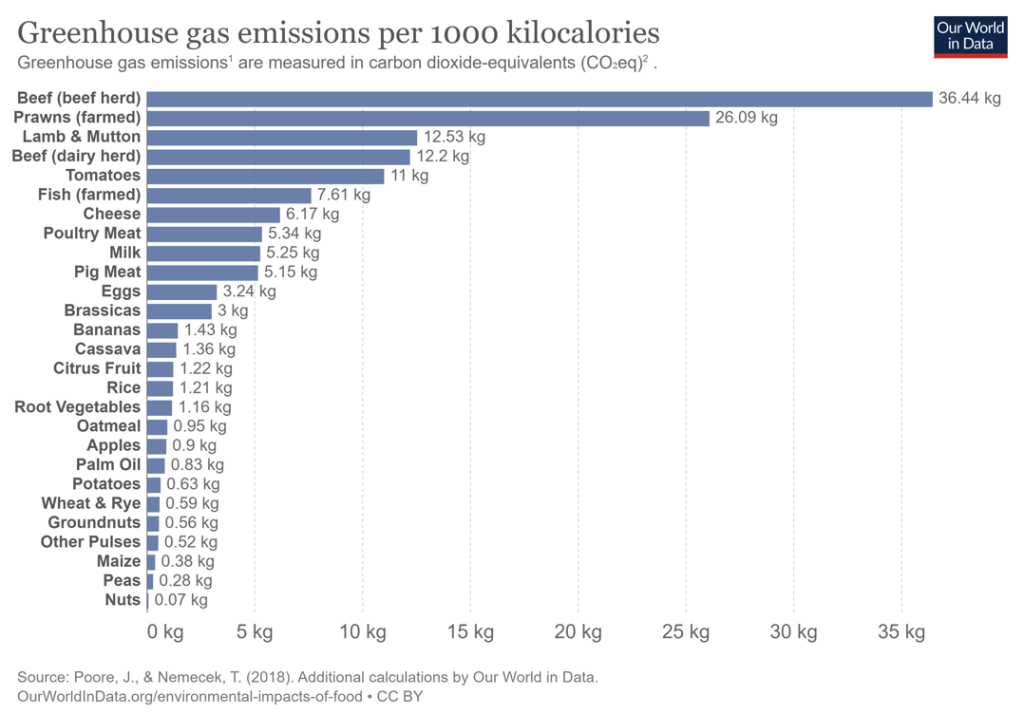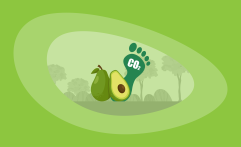What Is the Carbon Footprint of Garlic? A Life-Cycle Analysis
Impactful Ninja is reader-supported. When you buy through links on our site, we may earn an affiliate commission.
Learn more
Learn more
.
Hey fellow impactful ninja ? You may have noticed that Impactful Ninja is all about providing helpful information to make a positive impact on the world and society. And that we love to link back to where we found all the information for each of our posts. Most of these links are informational-based for you to check out their primary sources with one click. But some of these links are so-called "affiliate links" to products that we recommend. First and foremost, because we believe that they add value to you. For example, when we wrote a post about the environmental impact of long showers, we came across an EPA recommendation to use WaterSense showerheads. So we linked to where you can find them. Or, for many of our posts, we also link to our favorite books on that topic so that you can get a much more holistic overview than one single blog post could provide. And when there is an affiliate program for these products, we sign up for it. For example, as Amazon Associates, we earn from qualifying purchases. First, and most importantly, we still only recommend products that we believe add value for you. When you buy something through one of our affiliate links, we may earn a small commission - but at no additional costs to you. And when you buy something through a link that is not an affiliate link, we won’t receive any commission but we’ll still be happy to have helped you. When we find products that we believe add value to you and the seller has an affiliate program, we sign up for it. When you buy something through one of our affiliate links, we may earn a small commission (at no extra costs to you). And at this point in time, all money is reinvested in sharing the most helpful content with you. This includes all operating costs for running this site and the content creation itself. You may have noticed by the way Impactful Ninja is operated that money is not the driving factor behind it. It is a passion project of mine and I love to share helpful information with you to make a positive impact on the world and society. However, it's a project in that I invest a lot of time and also quite some money. Eventually, my dream is to one day turn this passion project into my full-time job and provide even more helpful information. But that's still a long time to go. Stay impactful,Affiliate Disclosure
Why do we add these product links?
What do these affiliate links mean for you?
What do these affiliate links mean for us?
What does this mean for me personally?
![]()
The average American eats two pounds of garlic a year, and 14% of us put garlic on nearly everything we cook. Garlic has a host of health benefits and medicinal properties, and could help reduce cholesterol and heart disease. Furthermore, it contains antioxidants that may prevent the common cold, dementia, and Alzheimer’s disease. Yet, much less is shared about the environmental impact, and especially the carbon emissions of garlic. So we had to ask: What is the carbon footprint of garlic?
Garlic has a carbon footprint of 0.18 kg (0.4 lb) of CO2e per pound of produce. This is a very low carbon footprint in comparison to other vegetables, and is largely because garlic is often sold without plastic, has a long shelf life, and often requires few resources, such as pesticides, to grow.
In this article, we’ll walk you through the overall carbon emissions of the life-cycle of garlic. From growing and packaging, to transporting and end-of-life practices, you will learn how this vegetable affects the planet and discover some ways to reduce and offset the footprint.
Here’s How We Assessed the Carbon Footprint of Garlic
The carbon footprint is one of the ways we measure the effects of our human-induced global climate change. It primarily focuses on the greenhouse gas (GHG) emissions associated with consumption, but also includes other emissions such as methane (CH4), nitrous oxide, and chlorofluorocarbons, and is generally expressed in carbon dioxide equivalents (CO2e).
“Carbon footprint: the amount of greenhouse gases and specifically carbon dioxide emitted by something (such as a person’s activities or a product’s manufacture and transport) during a given period”
Merriam Webster
Basically, it is the amount of carbon emitted by you as an individual or an organization providing you with goods and services – including garlic:
- This includes GHG emissions from producing the products that we use and foods that we eat (e.g., power plants, factories or farms, and landfills)
- GHG emissions from fuel that we burn directly or indirectly (e.g., logistics and transportation, cooling or heating facilities),
- as well as the GHG emissions attributed to how we consume these products and foods.
To understand the carbon footprint of garlic, we must assess its life-cycle and each stage’s sustainability. This life-cycle assessment (LCA) is a method to evaluate the environmental impacts of products and materials.
Here’s the Overall Carbon Footprint of Garlic
The overall carbon footprint of garlic is 0.18 kg (0.4 lb) of CO2e per pound of produce, which is low for crops. Garlic produces less than half of the carbon emissions of salad mix, and under a fifth of the carbon emissions of cucumber.
Garlic is a popular way to add flavoring to many dishes, so it is important to know the carbon footprint associated with this vegetable. Then, you can make sustainable choices when it comes to your food.
| The carbon footprint of garlic | 0.18 kg (0.4 lb) of CO2e per pound of garlic |
So, let’s have a look at each stage of the LCA of garlic!
| The life-cycle stages of garlic | Each stage’s carbon footprint |
| Growing of garlic | The carbon footprint of growing garlic is 0.13 kg (0.3 lbs) of CO2e per pound of produce. This makes up 74.57% of the overall carbon footprint of this plant. The significant land usage, long growing period, and water irrigation systems used make up a large part of this figure. |
| Harvesting, processing, and packaging of garlic | The carbon footprint of harvesting, processing, and packaging garlic is <0.05 kg (<0.1 lbs) of CO2e per pound of produce, which makes up 16.46% of the overall carbon footprint. Unprocessed and unpackaged garlic has a lower carbon footprint, as less resources are required. |
| Transporting of garlic | The carbon footprint of transporting garlic is <0.05 kg (<0.1 lb) of CO2e per pound of produce which amounts to 8.98% of the overall carbon footprint. This is impacted negatively by the 2.5 million tonnes of garlic imported to the US per year, mostly from China. |
| End-of-life of garlic | The carbon footprint of the end-of-life of garlic is largely impacted by the amount of food wasted. Around 20 million garlic cloves are wasted a year. Choosing loose garlic reduces the plastic waste of this crop. |
These four stages can be broken down in more detail to understand why the carbon footprint of garlic is relatively low in comparison to other vegetables.
What Is the Carbon Footprint of Growing Garlic
The carbon footprint of growing garlic is 0.13 kg (0.3 lbs) of CO2e per pound of produce. This makes up 74.57% of the overall carbon footprint of this plant. The significant land usage, long growing period, and water irrigation systems used make up a large part of this figure.
Garlic is relatively easy to grow, and requires little maintenance. Often the growing stage of a crop’s life cycle produces a majority of carbon emissions due to the land, water and resources needed. Although the majority of carbon emissions are created in this stage of garlic production, the overall carbon footprint of this crop is low.
Which factors impact the carbon footprint of growing garlic?
- How do garlic grow: Garlic cloves are planted, and they grow underground into bulbs. Underground vegetables generally require fewer resources than vegetables grown above ground in fields or energy-intensive greenhouses.
- What is the growth duration of garlic: Garlic cloves take about nine months to mature. This is quite a long growing period. In general, crops with long growth-periods use up more resources and have a greater impact on the carbon footprint. However, garlic is very low maintenance, meaning that the carbon footprint is not impacted greatly by this long growth duration.
- What is the land usage of garlic: An average yield of garlic is 6-10 tons of cloves per hectare. This is quite a low yield in comparison to other root vegetables. For example, onions produce 18-40 tons per hectare, and potatoes yield 40-70 tons per hectare. However only 400 million pounds of garlic are produced in the US annually, whereas over 45 billion pounds of potatoes are grown in the US each year. This means that the overall land usage of garlic is much less, despite its lower yield.
- What is the water usage of garlic: Garlic requires half an inch to one inch of water per week. Despite being quite a drought-resistant plant, garlic has shallow roots, meaning that in order for bulbs to grow, irrigation is recommended. Drip irrigation contributes to the carbon footprint of this plant.
- What is the pesticide and fertilizer usage of garlic: The Environmental Working Group found no overall concerns with garlic, in regards to the pesticide usage while growing this crop. Insecticides are rarely used, and in fact, garlic itself can be used as a natural insecticide. The use of pesticides impacts negatively on the carbon footprint of a crop because they produce carbon emissions through manufacturing, transportation, and application. Since there is not a high pesticide usage when growing garlic, the carbon footprint is not impacted largely by this.
In short, growing garlic accounts for the majority of the carbon footprint of this plant. Land, water, and growth duration, are key factors towards this.
What Is the Carbon Footprint of Harvesting, Processing, and Packaging Garlic
The carbon footprint of harvesting, processing, and packaging garlic is <0.05 kg (<0.1 lbs) of CO2e per pound of produce, which makes up 16.46% of the overall carbon footprint. Unprocessed and unpackaged garlic has a lower carbon footprint, as less resources are required.
Garlic is often sold loose, which is part of the reason why it has a lower carbon footprint than vegetables which are frequently packaged in plastic, such as salad mix. However, the processing stages and machine-harvesting of this crop contribute to the carbon emissions of this stage.
Which factors impact the carbon footprint of harvesting, processing, and packaging garlic?
- How are garlic harvested: Garlic is harvested by a machine harvester. They are then cured in the field, and left in the shade for 2-3 days to dry out. This increases the shelf-life of this crop. The mechanical harvesters used are thought to be damaging up to a fifth of the global agricultural land. Also, these machines have negative impacts on soil health and release a lot of carbon emissions. Harvesting garlic by machine is less labor-intensive, but creates more carbon emissions.
- How are garlic processed: More than half of the garlic sold in the US is processed. Garlic can be processed in a multitude of ways, usually for ease of use. This includes pre-chopped, minced, pureed, pickled, powdered, distilled in oil, or frozen garlic. This processing requires a lot of electricity and resources, increasing the carbon footprint. However, these processed products could lead to less waste, due to extended shelf-life.
- How are garlic packaged: Garlic packaging differs from store to store, but many garlic bulbs are sold loose. Sometimes they are packaged in mesh bags, or polyethylene bags which increase the carbon footprint of this stage. Opting for loose garlic is a way to lower your personal carbon footprint.
In short, garlic that is unprocessed and sold loose has a lower carbon footprint than garlic packaged in plastic or sold pre-processed.
What Is the Carbon Footprint of Transporting of Garlic
The carbon footprint of transporting garlic is <0.05 kg (<0.1 lb) of CO2e per pound of produce which amounts to 8.98% of the overall carbon footprint. This is impacted negatively by the 2.5 million tonnes of garlic imported to the US per year, mostly from China.
Garlic is transported from overseas to satisfy consumer demands for year-round produce. This customer demand for non-seasonal crops has a negative impact on the carbon footprint of garlic.
Which factors impact the carbon footprint of transporting garlic?
- Where are garlic grown: The garlic capital of the US is Gilroy, California, which is home to the annual garlic festival. California is the leading garlic growing state, followed by Oregon and Nevada. The US is the fourth largest producer of garlic, but the first largest importer of garlic. Over 75% of garlic is imported from China, with imports also coming from Mexico and Argentina. This increases the food miles of garlic, having a negative impact on the carbon footprint. Purchasing locally grown garlic reduces the carbon footprint of this crop.
- How are garlic transported: Like the majority of fresh produce, garlic is transported in refrigerated vehicles. These vehicles can emit up to 29 times more potentially carcinogenic particulate matter and six times more nitrogen oxides than far larger, modern diesel truck engines. If garlic is purchased from local farms, the carbon footprint is decreased.
In short, a reliance on imported garlic, shipped from a long distance, significantly increases the carbon footprint of this plant. Shopping locally and seasonally is a key way to reduce the impact of purchasing garlic.
What Is the Carbon Footprint of the End-of-Life of Garlic
The carbon footprint of the end-of-life of garlic is largely impacted by the amount of food wasted. Around 20 million garlic cloves are wasted a year. Choosing loose garlic reduces the plastic waste of this crop.
Garlic has a long shelf-life and is often sold without packaging, meaning that the end-of-life of garlic should have a relatively low carbon footprint. However, garlic waste still often ends up in landfill, increasing the carbon footprint of this stage.
Which factors impact the carbon footprint of the end-of-life of garlic?
- How are garlic disposed of: 20 million garlic cloves are wasted every year. They are compostable, however, food waste in landfill is a big problem for the environment. 16% of all food is wasted on farms, largely for aesthetic reasons. The resources used to grow these crops just to discard them is enormous, and negatively impacts the carbon footprint of garlic. To reduce this waste, the demand for ‘wonky fruit’ has been rising. Buying imperfect produce will lead to farmers throwing away less crops, and reducing the carbon footprint.
- How is the packaging of garlic disposed of: Since garlic is often sold loose, there is little waste, which is a big factor in the low carbon footprint of this crop. On the other hand, processed garlic is often sold in plastic packaging, which creates a higher carbon footprint. Many of the polyethylene bags used for packaging are recyclable, as long as the polyethylene is not bonded with other plastics. This is because polyethylene is generally only recycled to make like-for-like products. However, a lot of plastic that we recycle ends up on the other side of the world, causing a threat to developing countries. So, it is much more sustainable to buy loose produce.
In short, buying unpackaged garlic, and storing it properly, leads to far less waste. Being conscious of the way you dispose of garlic waste will reduce your carbon footprint.
How Does the Carbon Footprint of Garlic Compare to Other Types of Food
Garlic has a very low carbon footprint compared to other vegetables. Additionally, vegetables tend to produce far fewer carbon emissions than other types of food, making garlic a highly sustainable choice!
Let’s see how garlic compares with other vegetables.
How Does the Carbon Footprint of Garlic Compare to Other Types of Vegetables
In comparison to other vegetables, the carbon footprint of garlic is very low. For example, cucumbers produce more than 5 times the carbon emissions of garlic. Salad vegetables tend to need more resources to grow, making their carbon footprint far higher than root vegetables.
So, garlic is a vegetable with one of the lowest carbon footprints. But how does it compare to other types of food?
How Does the Carbon Footprint of Garlic Compare to Other Types of Food in General
Root vegetables have a very low carbon footprint in comparison to other types of food. They produce around 31 times fewer greenhouse gas emissions than beef.
When it comes to greenhouse gas emissions (GHG), foods are often compared in terms of emissions per 1,000 kilocalories (as opposed to their weight in lbs or kg).

Additionally, since garlic is low in calories, a far greater amount of produce is needed to equal 1,000 kilocalories. Also small amounts of garlic are most commonly used as a garnish or flavoring, rather than eating a full ‘portion.’
- To eat 1,000 kilocalories, you would need to consume 900 grams, which is around 150 servings, 15 heads of garlic, or 32 ounces.
- In comparison to beef you would only need 4.6 servings to eat 1,000 kilocalories, or 16 ounces.
- Comparatively, vegetables can have a high carbon footprint per kilocalorie, but are enormously less calorific than animal-based food.
- More calorific plant-based foods, such as pulses and nuts, have a miniscule carbon footprint in comparison to animal-based proteins. A single portion of beef amounts to around thirty-two portions of garlic, in terms of calories.
- This means that per portion, you will be consuming fewer calories, and so the carbon footprint will not be as large as this graph suggests.
Even though the carbon emissions for garlic are low in comparison to other types of food, try to be mindful of the ways you can lessen your environmental impact when you purchase this crop.
How Can You Reduce and Offset Your Personal Carbon Footprint
All of the food you eat will have some form of carbon footprint, even when you buy foods with low CO2e, like garlic. However, there are still ways to offset and reduce your personal carbon footprint.
There are a few easy techniques to buy more eco-friendly garlic, and you can also find ways to offset the carbon footprint after your purchase.
How Can You Reduce Your Carbon Footprint When Shopping for Garlic
When shopping for garlic, consider these ways to lessen your impact on the environment:
- Shop locally and seasonally: Garlic is in prime season from summer to fall. Buying from local farms reduces the carbon emissions produced and makes it a much more sustainable choice. If you are near a local, small-scale farm, which harvests by hand, your purchase will be even better for the environment.
- Choose organic: Organic garlic has a much lower carbon footprint than non-organic vegetables, due to the lack of pesticide production, distribution, and the overall higher health of soil for crops, insects, and animals.
- Buy plastic-free: Avoid pre-processed and packaged garlic, and instead opt for whole, loose produce. This will decrease the overall carbon footprint of your purchase massively.
- Store your garlic correctly: Garlic can actually last for up to six months in the correct storage conditions, but moisture and light can lead to premature spoilage. Store it in a cool dark place, and freeze chopped garlic to lead to a longer shelf-life, and less food waste. To create even less waste, you could even use the skin of garlic to create your own garlic powder.
Taking these actions are a great way to lessen your own carbon footprint, but there are also ways to offset the impact of consuming garlic as well.
How Can You Offset Your Personal Carbon Footprint
Carbon offsets are reductions in carbon emissions that are used to compensate for carbon emissions occurring elsewhere – for example for the carbon emissions that are associated with garlic. They are measured in tons of CO2 equivalents and are bought and sold through international brokers, online retailers, and trading platforms on what is known as the global carbon offset market.
“Carbon Offset: a way for a company or person to reduce the level of carbon dioxide for which they are responsible by paying money to a company that works to reduce the total amount produced in the world, for example by planting trees”
Oxford Dictionary
In terms of garlic – and indeed all food types – there will always be a carbon footprint, because of the resources it takes to get your food from farms to the place where you’ll eventually eat them. And while there are ways to reduce your carbon footprint when shopping for garlic, carbon offsets would be a way to reduce your CO2e emissions all the way down to net zero (or even to become climate positive).
However, when you purchase carbon offsets, it’s important that they actually make a difference in offsetting (aka reducing) total carbon emissions. To achieve that, the following are key criteria:
- Carbon offset projects have to be effective (different projects have different effectiveness rates)
- Carbon offset projects have to be additional
- Carbon offset projects have to be permanent
- The claims from carbon offset projects have to be verifiable
To find the best carbon offsets for you personally, check out our full guide on the best carbon offsets for individuals, where you’ll also learn more about how these carbon offset projects work, what their respective offsetting costs are, and what your best way would be to offset your own carbon emissions.
Final Thoughts
Garlic has a very low carbon footprint when compared with other vegetables and an even lower carbon footprint when compared with other foods. However, you can try to reduce your carbon footprint even further by eating organic, reducing food and plastic waste, and purchasing local, seasonal produce. When you do enjoy garlic, think about whether you can offset the carbon emissions created, to make this healthy vegetable a more sustainable option!
Stay impactful,

Sources
- AgHires: 21 Garlic Ag Facts
- ABC27: What is the most popular garlic food in the United States?
- Healthline: 11 Proven Health Benefits of Garlic
- Britannica: Carbon footprint
- Science Direct: Life-cycle assessment (LCA)
- MIT SMR: Strategic Sustainability Uses of Life-Cycle Analysis
- CarbonCloud: Garlic
- Impactful Ninja: What Is the Carbon Footprint of Salad Mix
- Impactful Ninja: What Is the Carbon Footprint of Cucumber
- Global Trade: Global Garlic Imports Surged but Record Chinese Exports Curb Price Growth
- WRAP: The Food We Waste
- Environment Blog: Are greenhouses good or bad for the environment?
- Epic Gardening: How Long Does It Take For Garlic To Grow?
- Royal Horticultural Society: How to grow garlic
- WikiFarmer: Garlic Harvest Yield and Storage
- Impactful Ninja: What Is the Carbon Footprint of Onions
- Impactful Ninja: What Is the Carbon Footprint of Potatoes
- AgriFarming: How to Grow Garlic in the USA
- Montana State University: Potatoes: An Alternative to Consider
- Garlic Store: Does Garlic Need Water?
- WikiFarmer: Garlic Water Requirements and Irrigation Systems
- Environmental Working Group: Garlic
- California Garlic & Onion Research Advisory Board: A Pest Management Strategic Plan for Garlic Production in California
- The Garlic Farm: Make Your Own all-natural Garlic Sprays
- Canadian Food Focus: How is Garlic Harvested?
- AgriFarming: Garlic Farming
- BBC News: Farm machinery exacting heavy toll on soil – study
- Farms Wise: Are Tractors Bad for the Environment?
- US Department of Agriculture: Celebrate National Garlic Day with Facts about the Popular Cooking Ingredient
- Sustainability Times: Fresh versus frozen: a sustainable choice with a twist
- Frutas Hortalizas: Garlic
- World Atlas: The Top Garlic Producing Countries In The World
- Gilroy Garlic Festival: 2023 Gilroy Garlic Festival Association 43 Years of Tradition
- Agricultural Marketing Resource Centre: Garlic
- The ACR Journal: Refrigerated vehicles contribute to thousands of deaths and costs across EU
- World Wildlife Fund: Fight climate change by preventing food waste
- World Wildlife Fund: What farmers found when they measured fresh produce left in the field
- Edie: Wonky fruit & veg: turning an environmental problem into a social solution
- Let’s Recycle: Supermarkets to take back plastic film in-store
- Sesotec: Recycling more packaging –potential for PE and PP
- Live Science: The Plastic We ‘Recycle’ Is Actually Horrible for the Environment
- Impactful Ninja: What Is the Carbon Footprint of Tomatoes
- Impactful Ninja: What Is the Carbon Footprint of Bell Peppers
- Impactful Ninja: What Is the Carbon Footprint of Chili Peppers
- Impactful Ninja: What Is the Carbon Footprint of Asparagus
- Impactful Ninja: What Is the Carbon Footprint of Spinach
- Impactful Ninja: What Is the Carbon Footprint of Cauliflower
- Impactful Ninja: What Is the Carbon Footprint of Broccoli
- Impactful Ninja: What Is the Carbon Footprint of Celery
- Impactful Ninja: What Is the Carbon Footprint of Kale
- Impactful Ninja: What Is the Carbon Footprint of Corn
- Impactful Ninja: What Is the Carbon Footprint of Carrots
- Impactful Ninja: What Is the Carbon Footprint of Mushrooms
- Impactful Ninja: What Is the Carbon Footprint of Cabbage
- Impactful Ninja: What Is the Carbon Footprint of Eggplant
- Our World in Data: Greenhouse Gas Emissions per 1000 kilocalories
- Aprifel: Garlic
- Healthline: Beef 101: Nutrition Facts and Health Effects
- Garden Betty: The Trick of Knowing When to Harvest Garlic
- Columbia Climate School: Is Organic Food Really Better for the Environment?
- Food Network: How Long Does Garlic Last
- NDTV Food: Don’t Throw Away Onion-Garlic Peels, Make This Yummy Powder With It
- Impactful Ninja: 12 Best Carbon Offsets for Individuals




